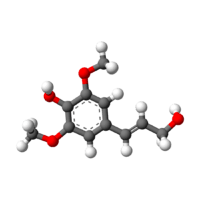Sinapyl alcohol
Sinapyl alcohol
 |
 |
| Names |
| IUPAC name
4-(3-hydroxyprop-1-enyl)-2,6-dimethoxyphenol |
| Other names
sinapoyl alcohol, 4-hydroxy-3,5-dimethoxycinnamyl alcohol |
| Identifiers |
| |
537-33-7  Y Y |
| ChEBI |
CHEBI:64557  N N |
| ChemSpider |
4444145  N N |
InChI=1S/C11H14O4/c1-14-9-6-8(4-3-5-12)7-10(15-2)11(9)13/h3-4,6-7,12-13H,5H2,1-2H3/b4-3+  N NKey: LZFOPEXOUVTGJS-ONEGZZNKSA-N  N NInChI=1/C11H14O4/c1-14-9-6-8(4-3-5-12)7-10(15-2)11(9)13/h3-4,6-7,12-13H,5H2,1-2H3/b4-3+
Key: LZFOPEXOUVTGJS-ONEGZZNKBU
|
| Jmol-3D images |
Image |
| KEGG |
C02325  N N |
| PubChem |
5280507 |
OC/C=C/c1cc(OC)c(O)c(OC)c1
|
| Properties |
| |
C11H14O4 |
| Molar mass |
210.226 |
| Appearance |
colourless solid |
| Melting point |
61 to 65 °C (142 to 149 °F; 334 to 338 K) |
Except where noted otherwise, data is given for materials in their standard state (at 25 °C (77 °F), 100 kPa) |
 N verify (what is: N verify (what is:  Y/ Y/ N?) N?) |
| Infobox references |
|
|
Sinapyl alcohol is an organic compound derived from cinnamic acid. This phytochemical is one of the monolignols. It is biosynthetized via the phenylpropanoid biochemical pathway, its immediate precursor being sinapaldehyde. Sinapyl alcohol is a precursor to lignin or lignans. It is also a biosynthetic precursor to various stilbenoids and coumarins.

